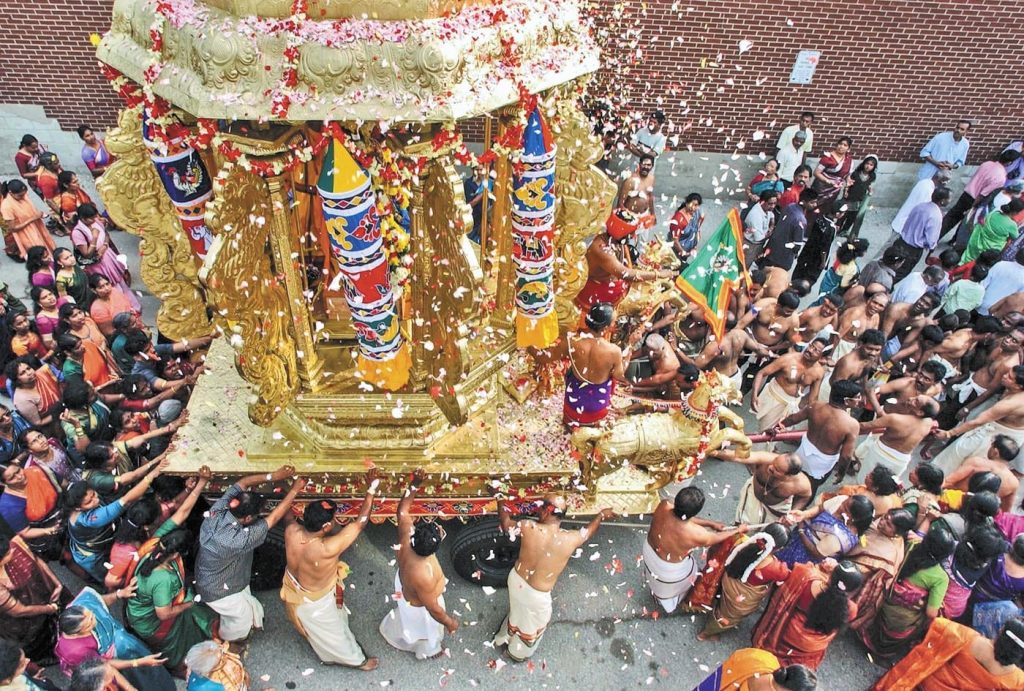JOYOUS OCCASIONS THAT ARE THE HEART AND SOUL OF SANATANA DHARMA
Hinduism is celebratory by nature. Hindus miss no opportunity to set mundane matters aside and join with family, friends, neighbors and strangers alike to feast and have fun, to renew the home and the heart and, most importantly, draw nearer to God.
Festivals are perhaps more impressive and varied in Hinduism than in any other religion. The devout Hindu knows these are times of profound mysticism, when God and the Gods touch our world, revitalize our souls, lighten karmas and bless our families.
Yet festivals do even more than this: they are essential to the perpetuation of religion, periodically reigniting the spark of zeal and devotion in the community. They provide the spiritual public square where Hindus engage with one another, affirming shared values and enjoying life’s intersections.
Before each celebration, vows are taken, scriptures are studied, pilgrimages are trodden and fasts observed in preparation—all individual acts of intimate devotion that bring the devotee closer to the Gods and keep him on the path to his inmost Self. As each festival begins, solitary adoration becomes a collective ritual, with millions of people taking their places in an ad-hoc choreography. Tradition is followed, but the result is never the same; every festival is special and unforgettable in its own way.
Thus the Hindu is reminded of his faith by the sounds, scents and the wild medley of tastes laid out for the feast. His mind and emotions are imbued with Hinduism as sacred mantraprayers are intoned, the spiritual teachings are recounted by saints and the Gods are praised in melodious bhajans.
Each state of India, indeed each village, lends a little of its unique culture to how a festival is celebrated, creating almost endless variations. And recently, with the growing Hindu population outside of India, festivals have acquired an international dimension. They provide a window into Hinduism for the non-Hindu populations in countries as far flung as Norway, Chile and Canada. At the same time, for Hindus immersed in foreign and often very alien cultures, festivals are the most visible and memorable sign of their heritage. Celebrated with unmatched fervor but with paced regularity, festivals serve as a reminder of one’s identity and allegiance to Hindu traditions and ideals.
What could be more entertaining, alive, vibrant and yet pious and rich in symbolism than a Hindu festival? Professor Dr. Shiva Bajpai remarked that it is through festivals that most Hindus experience their religion: “Festivals, pilgrimages and temple worship are the faith armor of Hindus.”
Hindu Festivals For the Media
Join Hinduism Today in educating the press with
accurate and uplifting information about Hinduism
Imprecise information, unflattering photos and an obsession for the bizarre are common when the media features our faith. For most Hindus, there seems little or nothing that can be done about this, except to practice detachment and soulful acceptance. That was the tone at a 2007 Hindu conference in Dallas, Texas, until suddenly the leaders collectively declared, “Enough.” Determined to complain less and do more, they masterminded the Hindu Festival Media Initiative, a strategic project designed by Hinduism Today in collaboration with the Sanatana Dharma Foundation.
There could be no better time to educate the public about Hindu religion and culture. In 2009, for example, President Obama attended the first Diwali celebration at the White House, an historic moment, complete with Sanskrit chants by a Hindu priest in full garb. Yet, not a single media report rightly explained the festival of lights; a proper description of the festival was found only in the President’s brief but inspired speech.
The Pager Project: We selected fifteen major festivals as the core of the project (of which seven are in this Insight). Then, collaborating with Soumya Sitaram posters of Bengaluru, we created a series of “pagers”—ready-to-print, newspaper-sized resources. They match standard US newspapers in journalistic style and size, making them easy to use, especially for publishers with limited staff. Each pager highlights a festival in its celebratory, community and family aspects. In the “Fact and Fiction” section and elsewhere, the pagers introduce Hindu philosophical, cultural and spiritual ideas. These resources can also be sent to bloggers and digital publishers, who can repurpose them for their audience.
How the Program Works: Newspapers welcome input from faith communities if the material is of high editorial quality, with polished text and eye-catching photos—more so if it’s free. Motivated Hindus are encouraged to approach their local newspapers’ religion or lifestyle editors with the appropriate pager in the weeks before each festival. Editors may elect to use them as is, or draw from the graphics and words and adapt them to their own style. Television and public radio stations can also be approached; the pagers can provide a comprehensive and authentic summary for voice-overs. They are available on the web as teaching resources for families, schools, summer camps, temples, ashrams, bloggers, etc.
How You Can Participate: Talk to your local temple board, the local Hindu association and newspapers in your area. Visit hinduismtoday.com/magazine/april-may-june-2010/2010-04-introduction-to-the-festival-features/ for more information. At hinduismtoday.com/festival-pager-downloads/ you will find all the pagers in PDF format with instructions on how to best use them. No matter where you live, these festival summaries will provide your local media with informative, factual information about your faith. By preemptively explaining how Hindus experience and understand Sanatana Dharma, we bridge the “we/they” cultural gap, proactively in bringing more tolerance, acceptance and understanding into the world.
Ganesha Chaturthi
Honoring the Lord of Beginnings
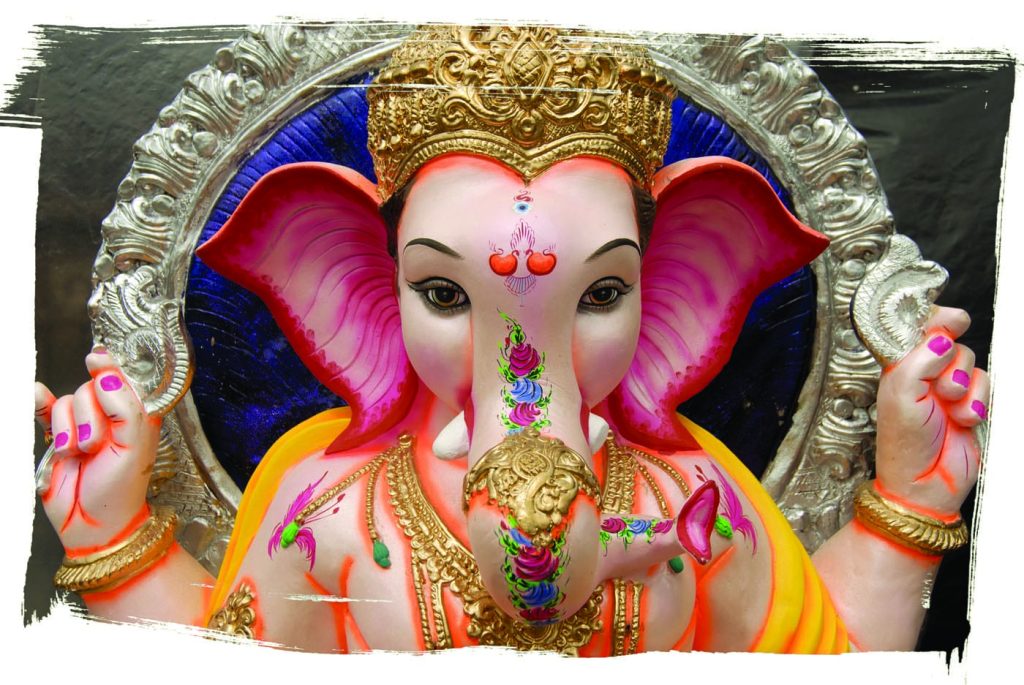
During Ganesha Chaturthi, a ten-day festival in August/September, elaborate puja ceremonies are held in Hindu temples around the world honoring Ganesha, the benevolent, elephant-faced Lord of Obstacles. In millions of home shrines, worship is also offered to a clay image of Ganesha that the family makes or obtains. At the end of ten days, Hindus join in a grand parade, called visarjana in Sanskrit, to a river, temple tank, lake or seashore, where His image is ceremonially immersed, symbolizing Ganesha’s merging into universal consciousness.
Who is Ganesha?
Perennially happy, playful, unperturbed and wise, this rotund Deity removes obstacles to good endeavors and obstructs negative ventures, thus guiding and protecting the lives of devotees. He is the patron of art and science, the God inhabiting all entryways, the gatekeeper who blesses all beginnings. When initiating anything—whether learning, business, weddings, travel, building and more—Hindus seek His grace for success. He is undoubtedly the most endearing, popular and widely worshiped of all the Hindu Deities. Ganesha Chaturthi (also called Vinayaka Chaturthi) falls on the fourth day in the waxing fortnight of the month of Bhadrapada in the sacred Hindu lunar calendar, which each year translates to a certain day in August-September. It is essentially a birthday celebrating Ganesha’s divine appearance.
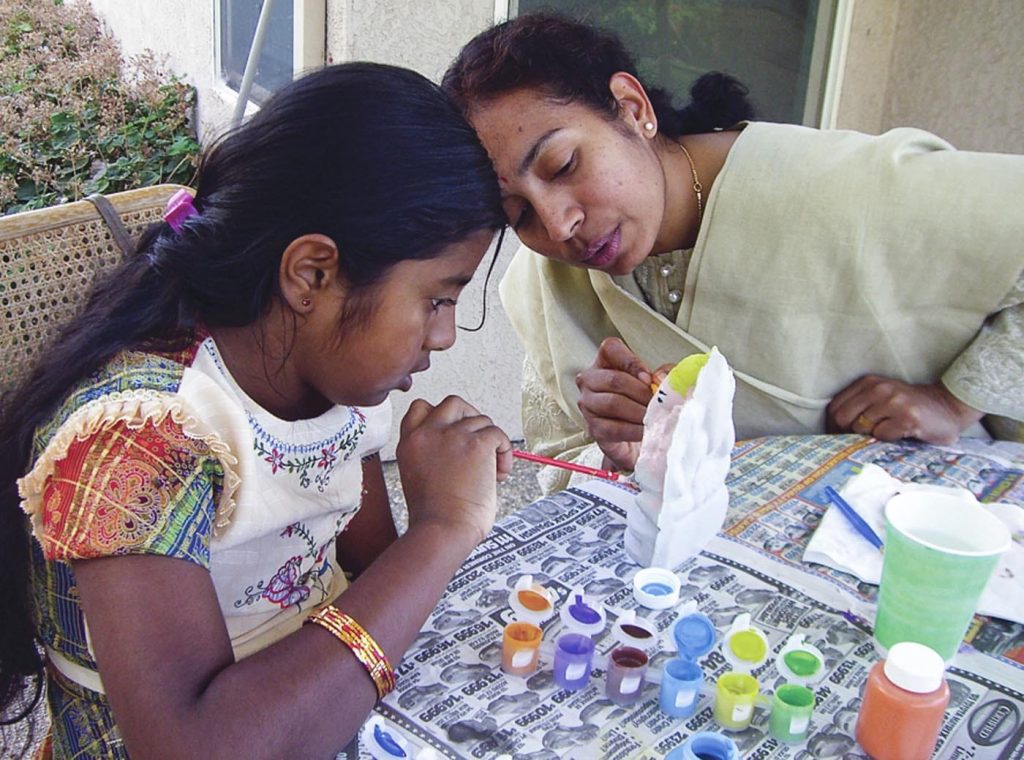
What do people do on Ganesha Chaturthi?
Devotees often fashion or purchase a Ganesha statue out of unbaked clay. Many sculpt Him out of a special mixture of turmeric, sandalwood paste, cow dung, soil from an anthill and palm sugar. The Deity image is placed in the home shrine amongst traditional decorations. A rite of worship and prayer, called puja, is conducted daily, invoking the energies of the Deity and inviting Him to reside in the clay image. Mantras are chanted and offerings are made throughout the puja, including incense, lighted lamps, cooked food (naivedya), fruits, durva grass, tulasi and pomegranate leaves—and flowers, especially red ones. After ten days, a simple puja is performed before the statue is taken for a formal departure (visarjana). Often entire communities, from dozens to tens of thousands of devotees, gather each year for this final day of ceremony. The icons are carried on an ornate metal tray—larger images are borne on a palanquin by several strong men—to a lake, a river or the sea. There Ganesha is consigned to the water after removing any non-degradable paraphernalia.
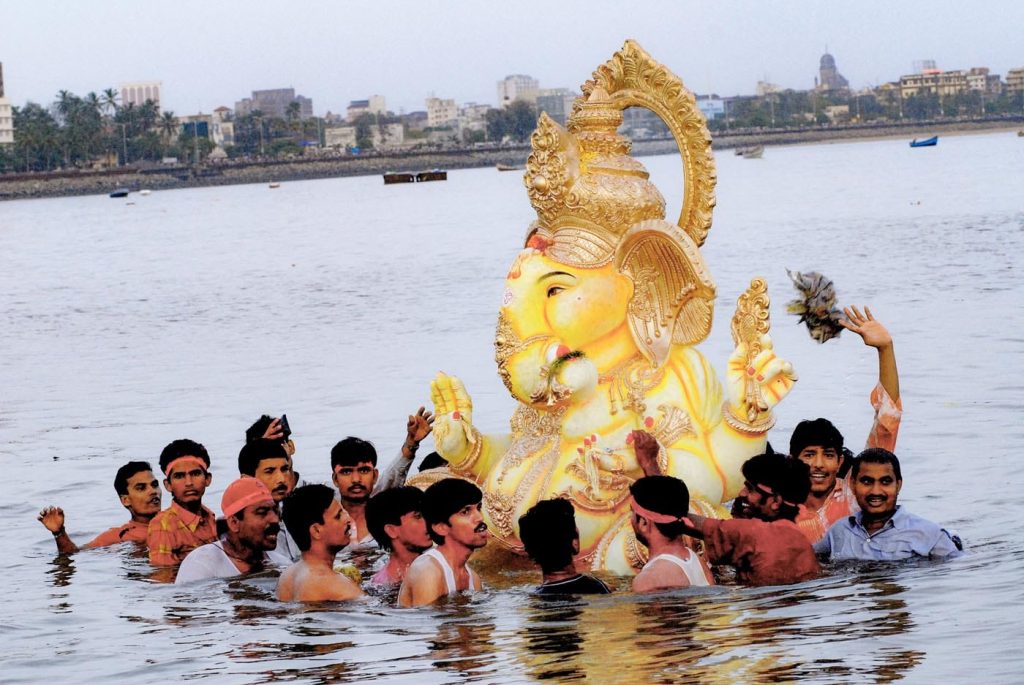
What foods are offered?
Sumptuous foods are specially prepared for Ganesha, keeping in mind His elephantine nature and prodigious appetite. People offer several varieties of fruits such as mangos, bananas and sugarcane. Sweets are the elephant-headed Deity’s delight, so to express their love families take great pains to make special tasty treats. Each family has its recipes.
Tidbits About Ganesha
❃ Where is this festival most popular? Nowhere is Ganesha Chaturthi observed with more creativity and enthusiasm than in Mumbai, India. The city virtually shuts down as millions of Hindus celebrate.
❃ Why is Ganesha worshiped first? Lord Brahma declared that any worship conducted without seeking Ganesha’s blessings would be fruitless. He is considered a loving, playful, protective Deity whose blessings would grace any endeavor. He is therefore ceremonially invoked before weddings, housewarmings, taking an important exam, starting a new business and other important events.
❃ What is His mystical work? Lord Ganesha is the God Hindus pray to when changes occur in their lives as they move from old established patterns into new ones. He is always there to steady the minds of devotees and open the proper doors as they evolve and progress.
❃ What makes Him distinctive? Aside from His unique and endearing elephant head, Ganesha carries an elephant goad to prod us along the right path. He holds a noose to lasso foes of dharma and to draw devotees close when they venture off the spiritual path. His mount is a mouse. His big belly is said to contain the fullness of the cosmos. In His hand is a modaka, fruit or other sweet, symbolic of enlightened attainments.
Modaka Sweets

These rich, deep-fried, fluffy, sweet dollops are the Mangalorean equivalent of the Tamil kollukattai. It is the all-time favorite of Lord Ganesha, who is described as Modaka Hasta, one with the modaka in His hand.
Preparation time: 10 minutes.
Cooking time: 30 minutes
Makes 20 pieces
Cooking equipment: A wok or deep saucepan, a perforated ladle, a lined colander to drain excess oil, a mixing bowl and serving plate.
Ingredients
4 cups thin beaten rice (poha),
1 cup semolina (rava) flour, 1 cup rice flour,
1 cup slightly over-ripe bananas, mashed,
1 cup powdered jaggery (or brown sugar), 1/8 tsp salt,
oil to deep fry
Method
1.
Mix all the ingredients together except the oil.
2.
Add a little water and knead the mixture gently into a thick paste.
3. Heat the oil in the wok.
4.
Drop tablespoonfuls of the batter into moderately hot oil and fry till rich brown. Drain and cool, then enjoy!
Fact & Fiction
FACT: There is not just one path to God Realization in Hinduism, but many. Tens of thousands of distinct teaching lineages prescribe varying combinations of prayer, rites and rituals, meditation, chanting and the many yogas to guide followers in their spiritual evolution.
FICTION: Many wrongly believe that Hindus worship cows. Hindus don’t worship cows. They respect, honor and adore the cow. By honoring this gentle animal, who gives more than she takes, Hindus honor all creatures.
Guru Purnima
Honoring the Illumined Teachers
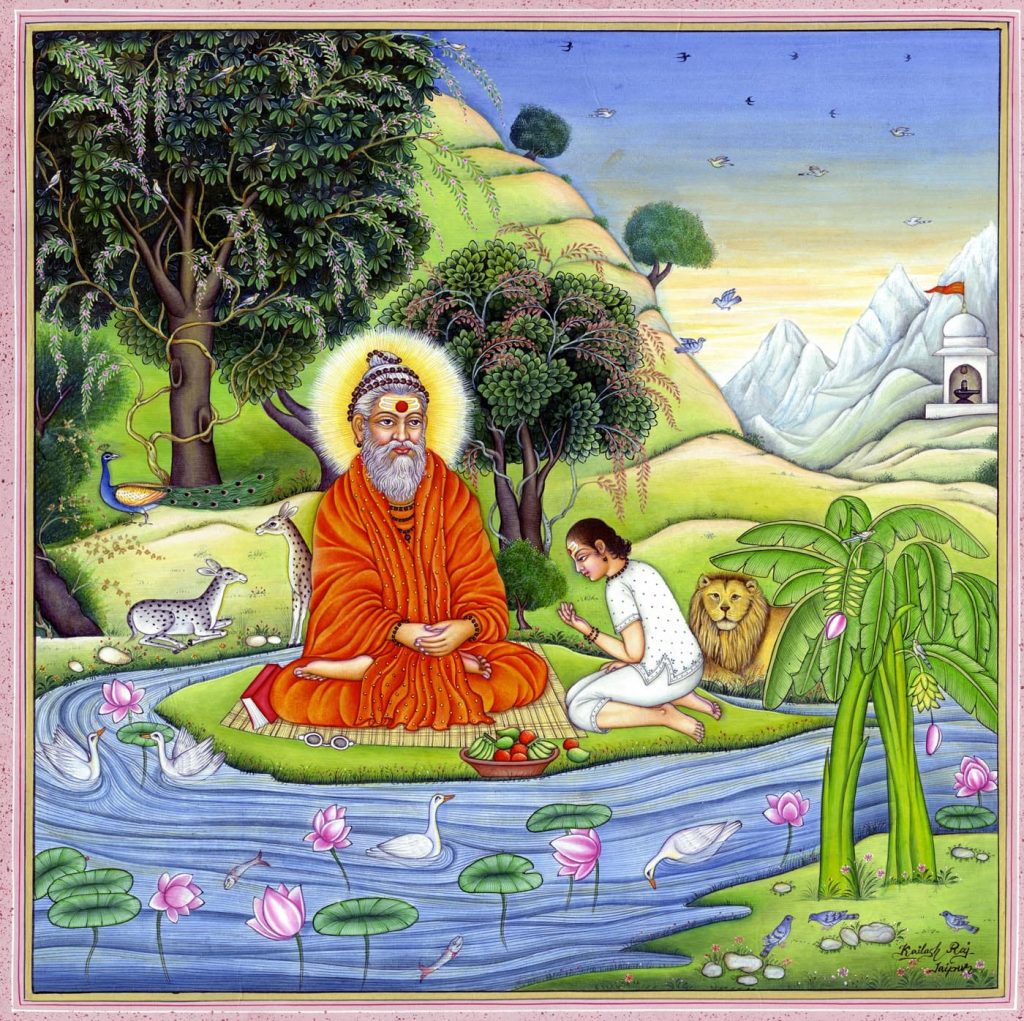
Hindu scriptures assert that more valuable than gold, and far more rare, is a guru, a knower of spiritual truths, also called a satguru. A guru is the devotee’s best friend, a father and a mother, a trusted confidant and a demanding mentor and guide on the path to God. The guru embodies all that the spiritual seeker aspires to be; in the guru, one sees his own infinite potential. Hindus honor these rare leaders on Guru Purnima, the full moon day in June/July, the Hindu month of Ashada.
What is Guru Purnima?
Guru Purnima is the annual festival which honors spiritual teachers, preceptors and mentors who dispel the darkness of ignorance by bringing forth wisdom and illumination. Purnima is the Sanskrit word for full moon.
What are the customs of Guru Purnima?
On this special day all of one’s thoughts are focused on the holy preceptor, tuning into his or her mind, meditating on his teachings and expressing gratitude for his or her blessings and guidance. In ashrams, monasteries, halls and home shrines, Hindus gather to venerate the guru of their lineage. The day’s primary activity is a formal ritual, called puja, in which his holy feet or a pair of his sandals are honored. At the guru’s major centers, the puja is a grand event, preceded by a festive procession. It is especially auspicious to pilgrimage to the guru’s ashram or monastery on this day.

Why is the full moon of Ashada the day of the guru?
In India, this day marks the start of the four-month monsoon season. Traditionally, mendicant saints do not wander during this inclement time, but settle in temporary camps where devotees gather to partake of their wisdom. The first day of learning was dedicated to honoring the preceptor, and it is believed this custom became established as Guru Purnima. The full moon is also known as a propitious time for attaining fulfillment, completeness and spiritual advancement, and for beginning all new endeavors.
Why are the guru’s feet the focus of veneration?
According to tradition, God’s presence can be most clearly and completely felt in the illumined satguru. To sit at his feet is to be close to God and our own deepest Self. All nerve currents terminate in the feet. Vital energy points relating to every organ of his physical and inner bodies—astral, mental and soul—are there. Touch the feet and we touch the spiritual master. Venerating the feet of the guru is also an acknowledgement of our deep respect and our knowledge that by following his footsteps we will attain spiritual perfection.
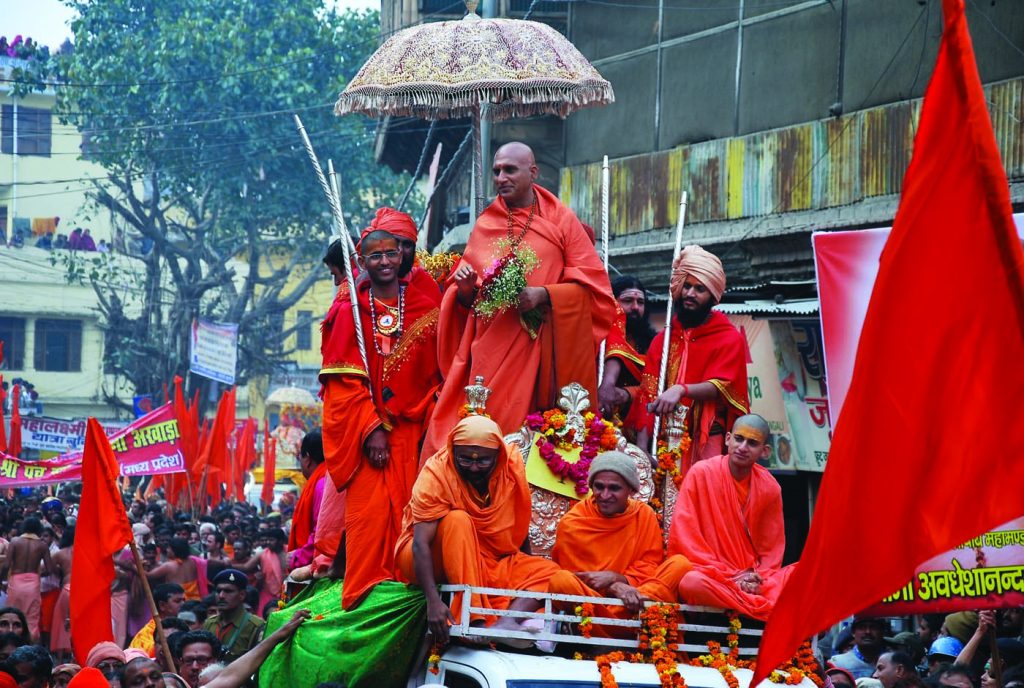
Are gurus worshiped as God?
A few Hindu denominations worship their gurus as the embodiment of God, and may even revere him as an avatar. But most Hindus see their guru as a great illumined soul in whom God’s presence is most powerfully apparent.
Tidbits About the Guru
❃ What is the guru’s role? It is the guru’s task to lead aspirants to God. He sets souls on the spiritual path, corrects those who stray, softens karmas, inspires lifelong practice and, through initiations, awakens the seeker’s superconscious knowing. He helps us become aware of our shortcomings and strengths and gives us tools to overcome weaknesses and refine ourselves. The guru, knowledgeable in Hinduism’s scriptures, its sacred, practical and philosophical treatises, has the ability to help us unlock their esoteric meaning and gain insight as we study. He guides us in our meditations, helping us navigate the mind and ultimately transcend it.
❃ What is darshan? Darshan, literally “sight,” is the mystical meeting of guru and devotee. Hindus travel great distances to experience darshan and receive the blessings of a illumined soul established in his enlightenment. Hindus believe that the spiritual power, called shakti, coming from a great soul accelerates their spiritual evolution, changes patterns in their life by purifying their subconscious mind, renewing their spirit and commitment to religious life.
❃ Are all gurus renunciate monks? Hindu spiritual teachers may be either unmarried renunciates or householders. Many Hindu institutions are led by luminaries who follow the householder path. Most gurus, however, are celibate monks—swamis, sadhus or acharyas—who have renounced worldly life and received initiation into a monastic order.
❃ Are gurus centrally organized? Hinduism is actually a multitude of faiths and lineages loosely bound together by common beliefs and practices. There is no central organization. Each guru within his or her own sphere of devotees is the authority on religious matters, his or her wisdom sought and words obeyed. Some are heads of institutions with large followings, while others are reclusive sadhus who rarely appear in public.
Traditional Offerings

When visiting a guru, just as when going to a temple, devotees bring an offering, such as flowers, fruits (a lime is traditional) and, for renunciate gurus, a piece of unstitched cloth. These items are presented in a basket or on a metal tray. A monetary gift, called dakshina, wrapped in a betel leaf, is often included. In ancient days, gurus were given gold by the king and cows by the wealthy to sustain their schools and allow them to freely share wisdom.
Fact & Fiction
FACT: Hindus consider the mother to be a child’s first guru. She and the father are responsible for their offspring’s upbringing, welfare and education. Upon coming of age, youth may turn to a satguru to begin their spiritual training.
FICTION: Some incorrectly criticize Hinduism as a world-negating faith that overemphasizes asceticism and austerity. In fact, while its large contingent of celibate monks pursue the path of renunciation, yoga and deep meditation, the vast majority of Hindus are householders dynamically engaged in family life, career and community service. Tradition affirms the pursuit of four goals: righteousness, wealth, pleasure (including sensual) and liberation.
Mahasivaratri
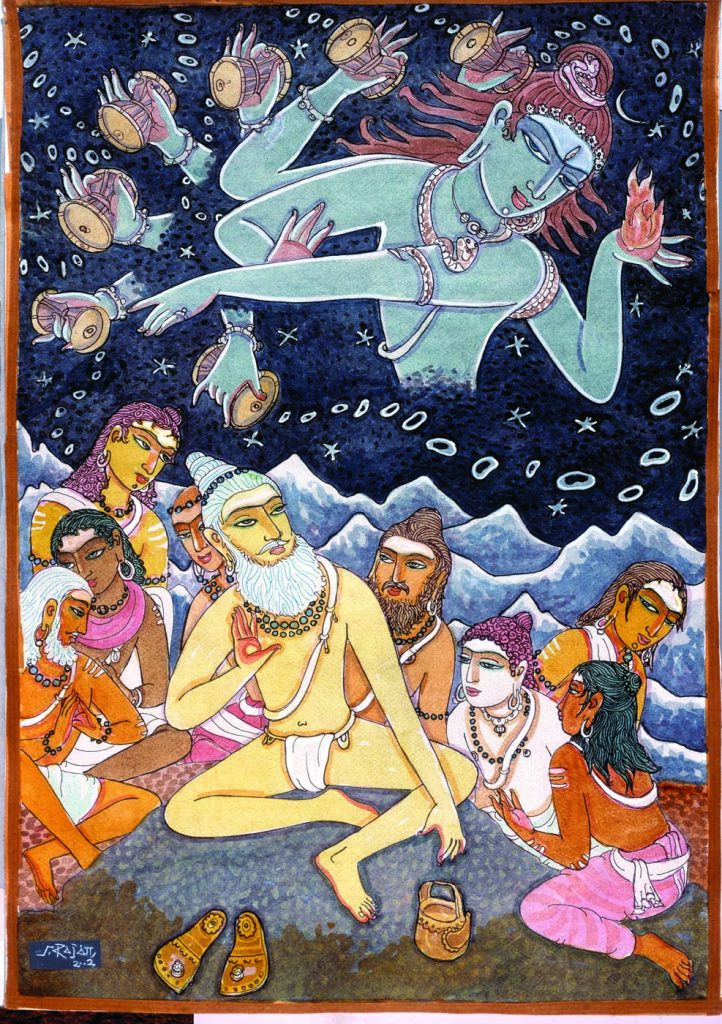
Siva’s Great Night
Mahasivaratri is the most important festival dedicated to God Siva. This holy day is observed by millions of Hindus all over the world. It is one of Hinduism’s most esoteric holy days, when yoga practices, mantras and meditation take the devotee closer to God’s essence within the core of himself. Hindus typically fast, maintain silence and stay up all night to perform spiritual practices, such as worshiping, chanting and singing. In some regions, devotees visit as many Siva temples as they can on this night.
Who is Siva?
For hundreds of millions of Hindus Siva is the Supreme Being, the absolute One God who both transcends creation and pervades it—thus existing as our own innermost essence. Siva is the powerful Deity whose energetic dance creates, sustains and dissolves the universe in endless cycles. He is the master yogi delving into unfathomable mysteries, the supreme ascetic, the prime mystic, the Light behind all light, the Life within all life. Siva is often called Mahadeva, “Great Being of Light,” for He created other, lesser Gods such as Ganesha and Karttikeya. Although Siva is usually depicted as male, in reality God and the Gods are beyond gender and form, as depicted by His half-male, half-female form, Ardhanarishvara. Parvati, regarded as Siva’s consort in village Hinduism, is mystically understood as His manifest energy, inseparable from Him. The ancient Tirumantiram scripture says of Siva, “Himself creates. Himself preserves. Himself destroys. Himself conceals. Himself all of this He does and then grants liberation—Himself the all-pervading Lord.”

What happens on Mahasivaratri?
Many Hindus perform an all-night vigil, plunging the soul into its own essence, led by Siva, the supreme yogi, who is both the guide and the goal of the search. Staying awake through the night is a sacrifice and a break from life’s normal routine, a time out of time to be with God within, to reach for the realization of our true, immortal Self. Siva is known as Abhisheka Priya, “He who loves sacred ablutions,” and thus many temples and home shrines have water always dripping on the Sivalinga. On this special night, Sivalingas are bathed with special substances, sometimes several times. Mahasivaratri occurs on the night before the new moon in February/March.
What is the Sivalinga?
Linga means “mark, token or sign.” A Sivalinga, representing Siva, is found in virtually all of His temples. The Sivalinga is the simplest and most ancient symbol of the Divine. It is especially evocative of Parasiva, God beyond all forms and qualities, the unmanifested Absolute. Sivalingas are commonly made of stone, but may also be of metal, precious gems, crystal, wood, earth or even transitory materials like sand or ice. Ardent devotees make special Sivalingas to worship during Mahasivaratri.

Is there a special mantra for Siva?
Namah Sivaya is among the foremost Vedic mantras. It means “adoration to Siva” and is called the Panchakshara, or “five-letters.” The five elements, too, are embodied in this ancient formula for invocation. Na is earth, Ma is water, Si is fire, Va is air, and Ya is ether, or space.
Tidbits About Mahasivaratri
❃ What is holy ash? Holy ash is a sacrament that is dear to devotees of Siva. Taken from sacred fires, it purifies and blesses those who wear it. This fine, white powder is worn on the forehead as a reminder of the temporary nature of the physical body and the urgency to strive for spiritual attainment and closeness to God.
❃ What is the special offering to Siva? Hindus believe that offering bilva leaves (Aegle marmelos) on Mahasivaratri is most auspicious. Legend tells of a hunter who was chased by a tiger. Scrambling up a thorny tree, he plucked and dropped its leaves to stay alert. The tree was a bilva, The leaves happened to fall on a Sivalinga, and it was the night of Sivaratri. That all-night worship of God, though inadvertent, earned the hunter liberation from rebirth. Siva accepts devotees irrespective of their faults and foibles, forgiving man’s cognizant and innocent mistakes.
❃ What is the Kumbha Mela? The Kumbha Mela is a grand festival held every few years in rotation at four places where several sacred rivers converge: Haridwar, Prayag, Nasik and Ujjain. The largest melas, at Haridwar and Prayag, fall in January to April and often include Mahasivaratri. Devotees come from near and far to immerse themselves in the holy waters, with prayers for purification and spiritual liberation on their lips. In 2001, the Kumbha Mela at Prayag, held on the river bank, was attended by more than 60 million people. It was the biggest human gathering held on Earth, seven times the population of New York City.
Fasting & Silence

Virtually every Hindu festival comes with a sumptuous list of foods to feast on, but during Mahasivaratri most Hindus fast. A spiritual practice found in almost all of the world’s religions, fasting calms the physical, mental and emotional energies, helping the devotee draw nearer to the ineffable Self within. While the strictest fast on nothing but water; others permit themselves fruits, milk or rice.
Many observe silence on this night, thinking of nothing but God. Silence, known in Sanskrit as mauna, quiets the demands of the mind and body, bringing forth spiritual clarity.
In Hinduism, God is not separate from His creation. A virtuous life and certain techniques, such as yoga and ascetic practices, enables us to remove the veil that makes us think of ourselves as separate from Him.
Fact & Fiction
FACT: Hindus undergo numerous traditional rites of passage at critical junctures throughout life. These ceremonies invoke divine blessings for the individual and help bind him with his community as he advances on the path of virtue. Name-giving, first feeding, commencement of learning, coming of age, marriage and cremation are primary examples.
FICTION: It is commonly believed that rituals are mandatory. In fact, there are no absolute requirements within Hinduism. Each devotee is free to practice his faith according to his family tradition and personal preferences.
Navaratri
Dedicating 9 Nights to the Goddess

Millions of Hindu women consider Navaratri the year’s central festival, the one they most deeply connect to. These nine days dedicated to Shakti, the Goddess, provide an opportunity to seek blessings and commune with their own divinity. It is a time for sacred gatherings, austerities, selfless acts and intimate prayers. But Navaratri is not just for the ladies; everyone turns out for the joyous worship, festivities, plays, feasting and dance—all venerating God as the loving Mother Spirit that gives life to everything.
What do Hindus do for Navaratri?
Navaratri starts on the new moon of September/October. On the first day, it is customary to plant seeds in a clay pot which will sprout over the next nine days. In some communities, women prepare a specially decorated kalasha, a vessel symbolizing the fertile womb, representing the Goddess. Especially in cities in Tamil Nadu, families create elaborate shelf displays, called kolu, of handmade clay dolls. Adding new dolls each year and handing the collection down to the next generation results in some grand displays.
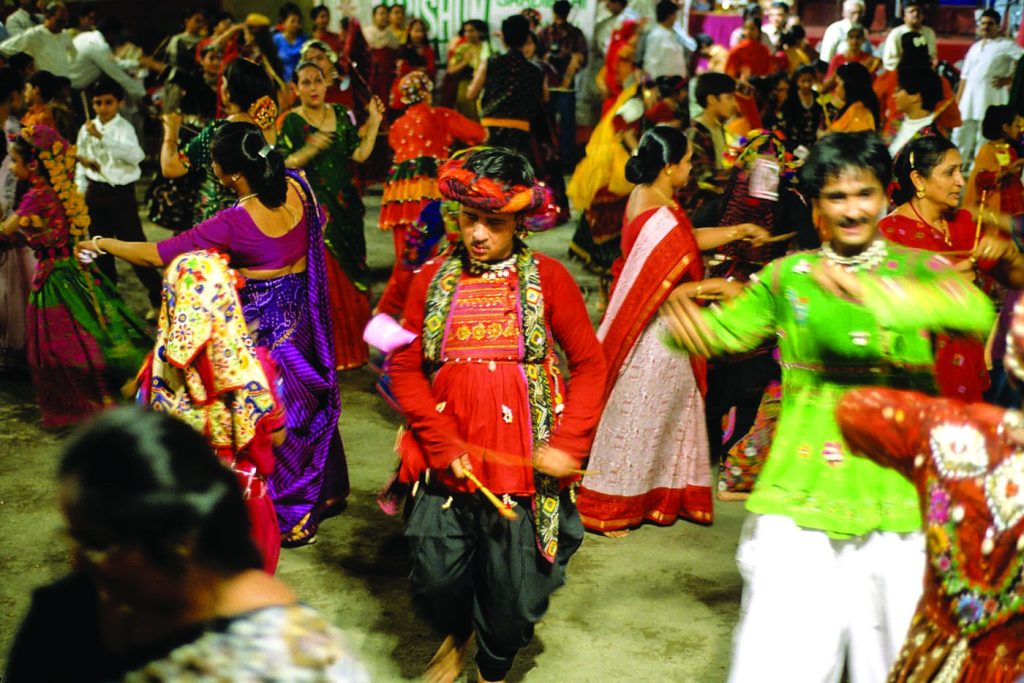
How is Navaratri observed in homes?
Each night, the Goddess “holds court,” and special food offerings are presented as prayers eulogizing Her powers are chanted. Guests are invited to showcase their artistic skills, and all enjoy sweets and other treats. Women dress up and visit female friends and relatives, taking a tray of offerings which includes the betel leaf and nut that bear the gravity of a formal contract of friendship and loyalty. Other items on the tray—beauty accessories, fresh turmeric root and coconut—symbolize goodwill and fertility. They fast, pray morning and evening, and give food and cooking pots to the poor. Some families formally honor a prepubescent girl each day, giving her new clothes, treating her to a sumptuous lunch, and pampering her, affirming her femininity and affinity with the Goddess.
How are Shakti’s forms worshiped?
In South India the first three days are dedicated to Goddess Durga, the fierce Mother who decimates negative forces. For the next three days, Lakshmi, the Goddess of prosperity, is revered. The last three days are dedicated to Sarasvati, the Goddess of learning and wisdom. In this way, Hindus honor women as the protectors of the family, extol their powers of fertility and endurance, venerate them as the source of good fortune and revere them as repositories of culture and learning. In North India one of the nine aspects of Durga is venerated each day. These nine days are celebrated by communities in East India as Durga Puja, treating the Goddess as the Daughter who has come to Her maternal home for an annual visit.
What is the final day?
Vijaya Dashami, “triumphant tenth day,” celebrates Durga’s legendary victory over Mahishasura, a powerful being fraught with ignorance and selfishness. On the same day, many celebrate Rama’s victory over the evil Ravana. The celebration is a reminder to persist in the challenges we face in life. Local traditions vary widely, and this day is known by other names, including Dussehra, Dasara and Dashain.

Tidbits About Navaratri
❃ What special events occur on Maha Navami, the ninth day? Books, musical instruments, equipment and tools are placed before Goddess Sarasvati for blessings, seeking Her gifts of talent, ability and inspiration. This rite, called Ayudha (weapon or tool) Puja, began when the kings of ancient India had their weapons blessed. Today any tool of one’s trade may be consecrated: craftsmen’s tools, books, offices, vehicles, computers, even iPhones! Devotees reflect on their skills, strengths, goals and needs. A key rite of passage for children ages three to five is performed on this day. Called vidyarambha, “beginning of learning,” it marks the start of a child’s formal education.
❃ Are there group festivities? In the evenings, devotees gather to dance in halls and public squares. The Garba, Gujarat’s popular folk dance, is a vigorous dance performed in circles while twirling, jumping, flailing the arms, clapping rhythmically and stepping in sync. In the Dandiya-Ras, sticks are part of the choreography. Dancing is a community expression of joy and togetherness.
Sundal

This is a high-protein, low-oil dish made from steamed or boiled whole chickpeas.
Preparation time: Approx. 1 hour
Serves: 6
Equipment: A pressure cooker, a ladle, a wok or saucepan and a dish
Ingredients
1 cup chickpeas, ½ tsp turmeric powder, 3 tbsp to ½ cup grated coconut, 1 tsp black mustard seeds, broken dried red chillies (to taste), ½ tsp asafoetida powder, sliced green chillies (optional), curry leaves, salt
Method
1.
Beforehand, soak the chickpeas for 12 hours. Cook with the turmeric powder and salt in a pressure cooker (1:2 ratio of beans to water) until soft but firm, not mushy. Drain and set aside.
2. Heat ghee; add the mustard seeds and let them pop.
3. Add the curry leaves, chillies and asafoetida; roast the mixture slightly.
4. Add the cooked chickpeas. Stir gently over a low flame, taking care not to mash them.
5. Add grated coconut and salt to taste. Mix well.
6. Enjoy!
Hinduism: Fact & Fiction
FACT: Hindus place high value on self improvement through education and learning of all kinds. In bygone days women and men were educated from age seven: students lived as part of their teacher’s family. Hindus revere women as the guardians of culture, family, religion, learning and prosperity. Modern Hindu society has the highest number of female spiritual leaders in the world.
FICTION: Many wrongly believe that Hindu women are prohibited from learning, performing rites, ritual and prayer. Hindu women are not oppressed or considered unequal to men, but honored and respected. Hinduism is the only major religion to honor God’s feminine power!
Diwali
Celebrating the Triumph of Goodness

If you rolled a bit of Christmas, New Year’s Eve and the Fourth of July all into one, then catered the affair with mountains of sweets and savory snacks, you would have a taste of what it means to celebrate Diwali, India’s best-known festival. It is a day of Hindu solidarity, when all Hindus gather in love and trust. It is observed by lighting rows of oil lamps and exchanging greeting cards, clothing and other gifts. Family bonds are strengthened and forgiveness sought. For many, Diwali marks the beginning of the new year. Joyous festivities and parties abound.
What occurs on Diwali?
Diwali (or Deepavali, “row of lights”) is celebrated by Hindus worldwide to commemorate the triumph of good over evil, knowledge over ignorance, hope over despair. Oil-wick lamps are lit in every household, along with colorful strings of electric lights, causing the home, village and community to sparkle with dancing flames. The festival falls on the day before the new moon in the month of Ashwin (October/November). Communities spare nothing in celebration. Lavish spreads of sweets and treats reflect unfettered partying. Diwali lehyam—a potent concoction made with ginger, pepper, ghee and more—is provided to help gourmands digest the sumptuous feast. Families reach out to each other with gifts of sweets, dried fruit and crunchy, salty treats. Everyone wears colorful new clothing and many even new jewelry. Girls and women decorate their hands with henna designs.

What does lamp-lighting signify?
In Hindu culture, light is a powerful metaphor for knowledge and consciousness. It is a reminder of the preciousness of education, self-inquiry and improvement, which bring harmony to the individual, the community and between communities. By honoring light, we affirm the fact that from knowing arises respect for and acceptance of others. Lighting lamps reminds Hindus to keep on the right path, to dispel darkness from their hearts and minds, and to embrace knowledge and goodness.
What legends are associated with Diwali?
In the sacred text Ramayana, Diwali marks the return of Rama to his kingdom after defeating Ravana, the demon king who ruled Sri Lanka and kidnapped Rama’s pious wife, Sita. It also celebrates Krishna’s victory over Narakasura, the demon of ignorance. Rama and Krishna are earthly incarnations, or avatars, of Vishnu.
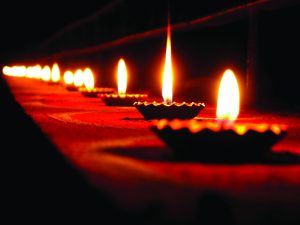
Does ritual bathing play a part?
Diwali marks the conquest of negative forces. To wipe away all traces of life’s struggle, the negative and draining energies of strife, Hindus invoke the waters of India’s holiest rivers—Ganga, Yamuna, Godavari, Sarasvati, Narmada, Indus and Kaveri—into water collected in urns in preparation for an ablution after an oil massage. The special bath cleanses the physical and auric energies of the individual. Fragrant powders of dried lentils, roots, aromatic seeds, leaves and flowers are used to remove the oil. Families then don fine new clothes, beautiful patterns are drawn on the ground, and lamps are lit until entire streets glow. The annual White House observance of Diwali in Washington, D.C., is illumined by the gentle glow of a standing oil lamp lit by the president.
Tidbits About Diwali
❃ What else is done for Diwali? Melas, or fairs, are held in all Indian towns and villages. In the countryside, the mela includes a festive marketplace where farmers bring their produce to sell and clothing vendors have a heyday.
❃ What are the giant effigies that are burned by big crowds? Huge effigies of Ravana, with ten heads, are built of straw and filled with firecrackers. They are burned as a joyous, symbolic cleansing from evil, and lights are lit in every home, just as residents of Ayodhya did to welcome home their victorious king, Rama.
❃ What about giving during Diwali? Gifts are freely exchanged, and special prayers are offered to Lakshmi for a prosperous year. Such ritual worship for abundance is also directed to Kubera, a celestial being who bestows riches to mortals. Some believe that, to preserve family wealth, money should not be borrowed, loaned or given away on Diwali or the day after.
Indian Carrot Sweet
Carrot Halwa
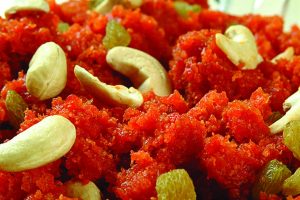
Preparation time: 20 minutes
Cooking time: 60 minutes
Serves: 6-8
Equipment: A small wok or round-bottomed pan, a ladle and a serving dish.
Ingredients
4 cups/1 kg grated carrots, 1 cup sugar, 2½ cups milk, 1½ ladles ghee,
a few cashews and raisins,
2 cardamom pods
Method
1. Wash, peel and grate the carrots.
2. Fry the cashews, raisins and cardamom in ghee and set aside.
3. Heat a ladle of ghee in the pan. Add the grated carrots and sauté.
4. Add enough milk to soak the carrots and cook on low heat, stirring occasionally, until carrots are soft. Add the remaining milk, a ladle at a time, and cook until the milk thickens, then stir in the sugar.
5. Cook over low heat until everything blends together into a firm mass that separates from the sides of the pan.
6. Garnish with the fried cashews, cardamom and raisins. Top with a little ghee and pistachio slivers for extra flavor.
Hinduism: Fact & Fiction
FACT: Believing that the Divine resides in all things, Hindus practice non-injury and hold a deep respect, bordering on reverence, for all living beings. This embracing attitude is reflected in India’s history of welcoming refugees from all cultures and faiths. By following dharma, Hindus eschew violence and terror. Secure in their faith, they interact harmoniously with their neighbors, regardless of religious affiliation.
FICTION: Many people wrongly believe that Hindus, being proud of their religion, may disdain other cultures. In fact, Hindus fully accept the spiritual efficacy of other paths and never proselytize.
Rama Navami
Birthday of Rama, the Ideal Man
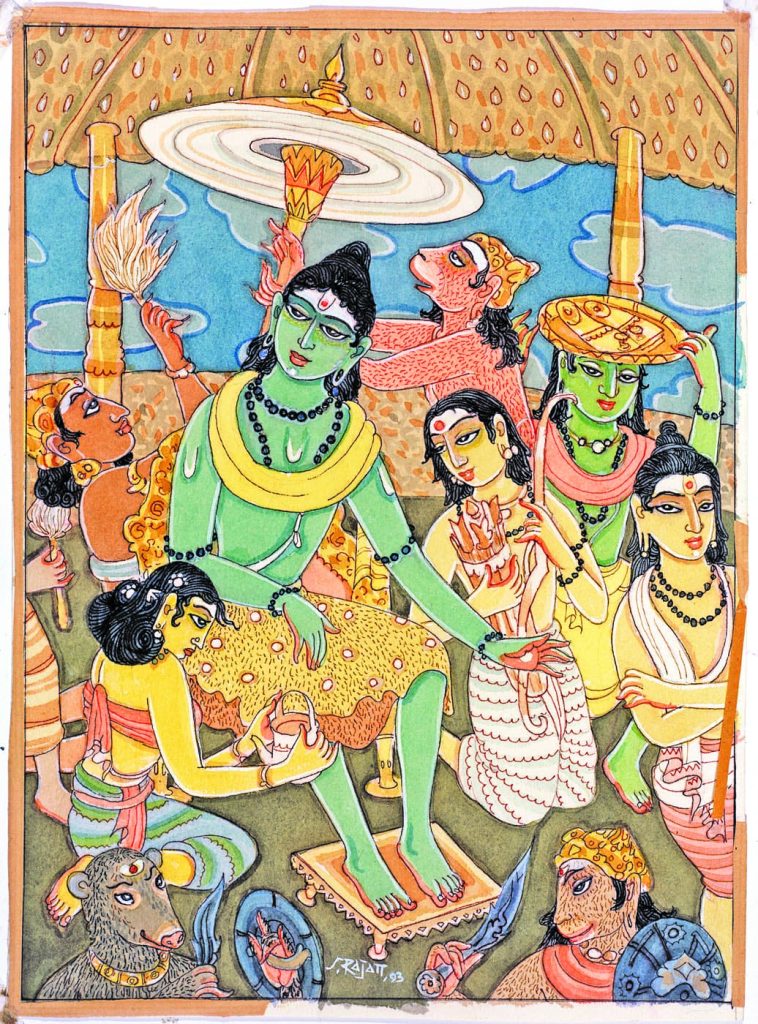
An incarnation of God, an ideal man, dutiful son and just king: these are just a few ways to describe Lord Rama, an exemplar of honor, reverence, self-control and duty. He fought battles, became king, married a Goddess, traveled far and befriended exotic beings who were steadfast in their loyalty and courage. Rama Navami is the celebration of His birthday, when Hindus honor and remember Him with devotional singing, dramatic performance and non-stop recitation of His remarkable life story, the Ramayana.
When is Rama’s birth celebrated?
Rama was born on navami, the ninth day of the waxing moon, in the Indian month of Chaitra (late March or early April).Sometimes the festival is observed for nine days before or after navami.

How do Hindus observe Rama Navami?
Devotees fast or eat only fruit or special food offerings prepared for the day. They participate in non-stop reading of the 24,000-verse epic Ramayana, at home or in a temple. Images or statues of baby Rama are placed in cradles and rocked by devotees. Homes resound with singing. In the evening, crowds attend Ramlila, in which storytellers and dance-drama troupes depict the Ramayana. It is common to remain awake the whole night, engaged in devotional practices. Devotees contribute generously to temples and charitable organizations. They make buttermilk and a lime drink called panaka, serving them to the public without charge.Some temples make khoa, a sweet made from thickened milk. This festival is especially popular in Uttar Pradesh, where Rama’s kingdom of Ayodhya is located.
Is the festival observed at temples?
Many temples hold grand celebrations on this day, especially those with shrines for Lord Rama, His wife Sita, His brother Lakshmana and His loyal friend Hanuman, Lord of Monkeys. Panaka and garlands of the sacred tulsi plant are offered as families pray for “Rama-Rajya,” a time when dharma will once again be upheld in the world. In South India, the day is celebrated as the marriage anniversary of Rama and Sita. A ceremonial wedding is held at temples with great fanfare.
Why is Rama so popular?
Rama is one of the ten avatars or incarnations of Lord Vishnu. He is revered as the perfect husband and ruler, who held duty to king and country above all else. He held strong to his ideals in the face of tremendous trials, including exile from His kingdom and separation from His beloved wife, Sita, herself an embodiment of virtue and truth. He is honored and glorified for His unshakable adherence to dharma, righteousness. The story of Rama is deeply influential and popular in the societies of the Indian subcontinent and across Southeast Asia.

What is the story of Rama?
A tale of love and separation, the Ramayana has moved the hearts of millions of Hindus over the ages. To honor a promise made by his father, King Dasaratha, prince Rama abandons His claim to the throne and spends 14 years in exile. Wife Sita and brother Lakshmana join him in exile, a time of perils and tribulations. Sita is abducted by Ravana, the monarch of Lanka. After a long and arduous search, Rama discovers Sita’s whereabouts, with the help of Hanuman. A colossal war ensues against Ravana’s armies. In a duel of majestic proportions, powerful and magical beings wield mighty weaponry in formidable battles. Rama slays Ravana and liberates Sita. Having completed His exile, Rama returns to be crowned king, loved by one and all.
Tidbits About Rama
❃ Who wrote the epic? Some 25 centuries ago, a sage ordered a thief to sit under a tree and chant “ma-ra” until he returned. Years passed, and an ant-hill covered the man, who had lost himself to the chant. The sage returned and broke the anthill, naming the thief Valmiki, meaning “from an anthill.” Inspired by his expanded awareness, Valmiki immortalized Rama by composing the Ramayana, a work unmatched in poetic excellence and longevity. Shri Ramcharitmanas by Tulsidas in Hindi and the Kamba Ramayanam by the poet Kambar in Tamil stand alongside Valmiki’s epic in Sanskrit.
❃ Who was Sita? Sita was a powerful, gifted, beautiful woman, utterly devoted to her husband. Found in the fields as a babe by King Janaka, Sita was raised as a princess. She walked alongside Rama in exile. When abducted by Ravana, she was unshakable in her faith that her husband would rescue her. She walked through fire to prove her purity. To prevent further slander, Rama sent her away to the forest. She patiently bore separation from her husband a second time and bore twins named Lav and Kush. When they were reunited with their father, she commanded Mother Earth to swallow her. The Earth split open and Sita disappeared.
Panaka
Sweet Indian Limeaide

Ingredients
½ cup of jaggery or brown sugar,
4 cups water, juice of one lime,
1½ tsp of grated fresh ginger, 1 tsp ghee or oil, a pinch of cardamom powder
Method
Mix ingredients and serve cold.
Spicy Buttermilk
Ingredients
2 cups buttermilk or yogurt,
2 cups water, 3 curry leaves, chopped coriander leaves (cilantro), 1 finely chopped green chilli, 1½ tsp ginger powder, 1 tsp mustard seeds, 1 pinch asafoetida, salt to taste
Method
Heat oil in saucepan and add mustard seeds; allow it to splutter, then add curry leaves, ginger, green chilies and asafoetida, stirring vigorously. Mix with remaining ingredients and beat until smooth.
Hinduism: Fact & Fiction
FACT: Hinduism has more than one sacred scripture, with several books considered revered or holy. While all Hindus revere the sanctity of the primordial Vedas, distinct sects recognize scripture that is most aligned with their theological beliefs, but not universal to all Hindus. Examples are the Agamas, Ramayana, Puranas and Mahabharata.
FICTION: Some deride Hinduism as primitive because certain of its Deities have animal features. Actually, most religions share this characteristic. The Greek God Pan and the Egyptian Deities Anubis and Horus are examples. In Christianity and Judaism, the biblical prophet Ezekiel describes the angels known as cherubim as having the faces of a lion, an ox, an eagle and a man, with the feet of a calf and four wings.
Thai Pusam
Honoring the God of Yoga

By many names we know Him. He is Murugan, the beautiful one. He is Dandapani, the God of yoga who guides us on the path to Self Realization. He is Kumara, the God of child-like love, holding steady the higher realms of creation. He is Karttikeya, the God of war, who arrives to end all conflicts with piercing wisdom and swift action. During January/February, the Tamil month of Thai, millions gather to worship and honor Him with fervor. He has a growing number of temples in North America and around the world.
How is Thai Pusam celebrated?
Devotees prepare themselves through prayer and fasting. On the day of the festival, many shave their heads, an act of sacrifice that symbolizes humility and the surrender of vanity. They undertake a pilgrimage to a place where Thai Pusam is being celebrated, usually a temple, while performing acts of devotion and penance. The most notable practices are the carrying of kavadis (“burdens”). Thai Pusam is observed in the Tamil month of Thai, between January 15 and February 15, when the Pushya star cluster, called Pusam in Tamil, rises with the full moon.
What is kavadi?
Kavadi is an offering carried by a devotee during a grand parade and offered to Murugan at the destination. The most common, pal kudam, is a pot filled with milk carried on one’s head. Less common but more impressive are the bamboo structures formed like a peacock or chariot, ornamented with symbols evocative of Murugan. Some of these heavy structures many feet tall and covered in peacock feathers. For weeks before the festival, kavadi carriers observe celibacy, take only fresh, light foods, while striving to think continuously of the Deity. Just before the sacred walk, they take a vow and pray for boons, often pledging some form of sacrifice or change in behavior. During the ordeal, many experience states of euphoria or trance.
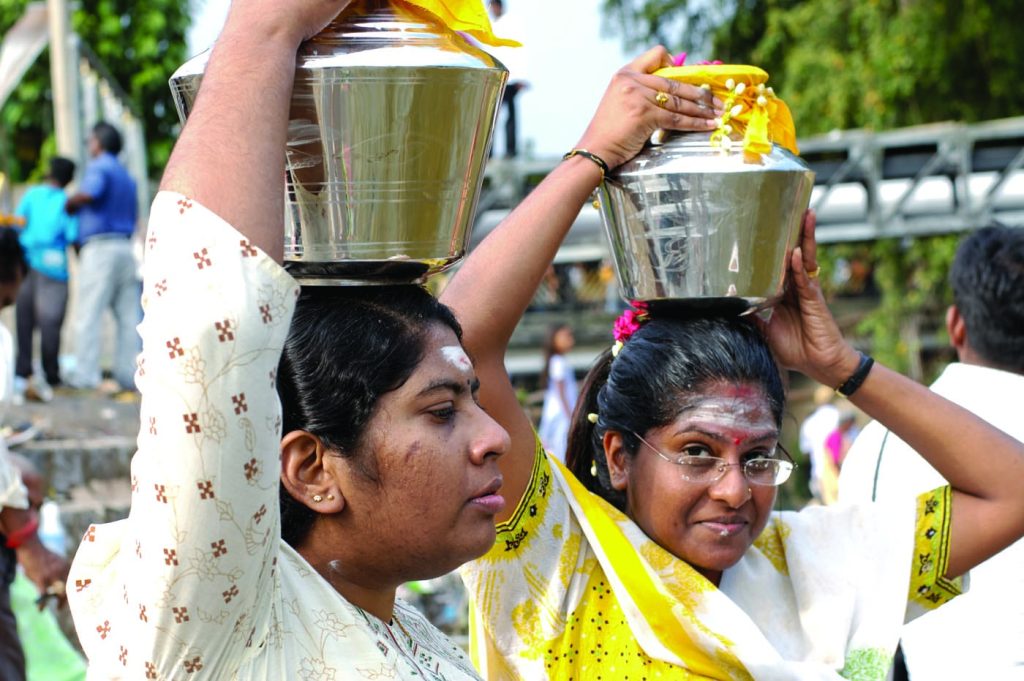
What is the purpose of kavadi?
Austerity strengthens willpower, clears the mind of regrets, resolves problems and brings closeness to God. Devotees believe that God will make any burden seem weightless as long as their faith is firm. Kavadi is the highest form of offering, a gift to God of personal effort and sacrifice.
What is Thai Pusam’s special significance?
This festival celebrates the moment in sacred legends when Lord Murugan, as the commander-in-chief of the divine army, defeated, using various spiritual powers, a mighty demon named Taraka who was wreaking havoc in all the worlds.
Where is Thai Pusam celebrated?
This festival is widely celebrated among Tamil communities in South India, Sri Lanka, Malaysia, Fiji, South Africa, Singapore, Mauritius, the Caribbean and North America. In South India, thousands walk barefoot for days to Palani Hills carrying colorful kavadis. The largest celebrations take place in Malaysia, where it is a public holiday. The temple at Batu Caves, near Kuala Lumpur, attracts a million devotees on that day.
Tidbits About Thai Pusam
❃ What other acts of penance are observed? After fasting and following other spiritual preparations, carriers of kavadi may ask a priest to pierce their bodies with small spears, replicas of Lord Murugan’s Vel. Other famous acts of penance include walking on hot coals and wearing nail shoes. It is considered a miracle of faith that fire walkers suffer no burns, and piercings do not bleed or leave scars.

❃ Why are these austerities performed? Fasting, head-shaving and kavadi are acts of devotion and penance to atone for misdeeds, earn spiritual merit and subdue the ego. Such austerities soften and relieve the burdens of karma, guilt, regret and troublesome memories. Through sacred rites and intense prayers, the Deity’s soothing blessings are received into the nerve system of the devotee. Penance, sincerely performed with the help of the angelic worlds, heals mental-emotional wounds and grants release from suffering.
God Loves a Parade
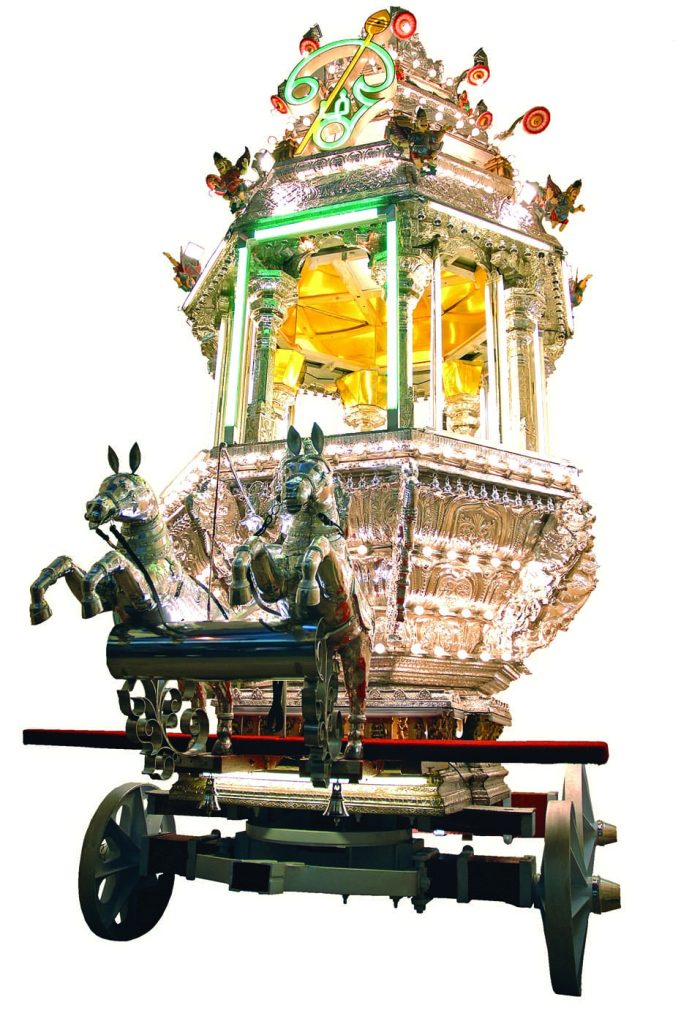
Many Hindu festivals feature a grand parade in which the Deity is taken through the streets. The procession attracts huge crowds, energizing devotees and bringing God’s blessings out to the city from the confines of the temple. It is not the temple’s main Deity image that is paraded, but a smaller statue or symbol. An ornate chariot built of wood and silver is pulled with huge ropes by throngs of devotees. The procession in Kuala Lumpur begins in the heart of the city and proceeds 15 kilometers—a slow, 8-hour journey—to Batu Caves. There the Deity is carried up the flight of 272 steps to the Murugan shrine inside the cave.
Hinduism: Fact & Fiction
FACT: Devotees who receive piercings and undergo other self-inflicting austerities during Thai Pusam do not bleed, suffer infections or experience prolonged pain after the events. Fasting, herbal salves, celibacy and a trance-like, exalted state mitigate the suffering commonly experienced when such practices are carried out unsupervised. Those who express devotion in such extreme ways are accorded reverential respect by the community.
FICTION: Many people believe that karma means “fate,” a preordained destiny over which one has no control. This is untrue. Karma is the process of action and reaction on all levels—physical, mental and spiritual. We each have the power to remold our future by the way we live now. If we sow goodness, we will reap goodness; if we sow evil, we will reap evil.
